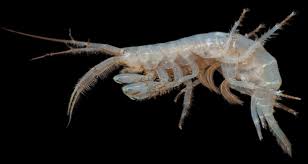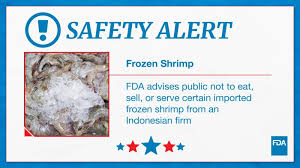
Introduction
Few phrases capture the imagination quite like “radioactive shrimp.” At first glance, it sounds like the punchline to a joke or the title of a campy B-movie. Yet beneath the strangeness of the phrase lies a fascinating subject at the intersection of marine biology, nuclear science, environmental studies, and cultural history. Shrimp, as one of the world’s most abundant and widely consumed crustaceans, serve not only as a culinary delicacy but also as an ecological sentinel. Because they are filter feeders and occupy an essential position in the marine food web, shrimp are highly vulnerable to environmental contamination—including radioactive isotopes.
The idea of radioactive shrimp is not entirely fanciful. From fallout after nuclear weapons testing to the Fukushima nuclear accident, shrimp and other seafood have indeed been contaminated by radioactive materials. Scientists have studied shrimp both in the laboratory and in natural settings to understand how radiation moves through marine ecosystems. Meanwhile, the cultural imagination has exaggerated the concept into glowing, mutant monsters and cautionary tales about technology gone wrong.
This article will explore the phenomenon of radioactive shrimp in its many dimensions: the basics of radiation in marine biology, historical cases of radioactive contamination, scientific studies on shrimp as bioindicators, the cultural mythology of radioactive sea life, the health implications for humans, and the potential role of shrimp in future biotechnology. Along the way, we will weave together history, science, and culture to give a comprehensive picture of what “radioactive shrimp” really means.
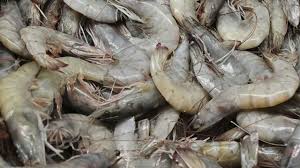
Understanding Radiation and Shrimp
What is Radiation?
Radiation refers to the release of energy as electromagnetic waves or subatomic particles. Not all radiation is harmful. We are constantly surrounded by non-ionizing radiation such as radio waves, microwaves, and visible light. The kind that concerns biologists and health experts is ionizing radiation, which has enough energy to remove electrons from atoms, creating ions. This process can damage living cells and DNA, potentially leading to mutations, illness, or death.
Ionizing radiation comes from both natural and human-made sources. Naturally occurring radioactive isotopes such as uranium, thorium, and potassium-40 exist in rocks, soil, and even within living bodies. Human activities—including nuclear weapons testing, energy production, and medical uses—create artificial isotopes like cesium-137, iodine-131, and strontium-90.
Shrimp in the Marine Ecosystem
Shrimp belong to the order Decapoda and inhabit oceans, rivers, and lakes across the globe. They play a dual role in ecosystems: as consumers of algae, plankton, and detritus, and as prey for fish, birds, and humans. This middle position in the food web makes them especially vulnerable to pollutants. Any contaminants entering the water can pass into shrimp and then to higher predators, including people.
When radioactive isotopes enter the ocean, they dissolve in water or attach to plankton. Shrimp, feeding on these microscopic organisms or filtering particles, can absorb radioactive material into their tissues. Because shrimp are widely distributed and relatively easy to sample, scientists often use them as bioindicators of environmental contamination.
Historical Background of Radioactive Seafood
Nuclear Weapons Testing and Fallout
During the Cold War, atmospheric nuclear weapons tests were conducted by the United States, Soviet Union, France, and other powers. These tests released billions of curies of radioactive isotopes into the atmosphere. Fallout eventually settled into soil and oceans. By the 1950s and 1960s, measurable amounts of isotopes such as cesium-137 were found in marine food chains.
Shrimp, being widely fished and exported, became a concern for consumers. Studies conducted in the Pacific and Atlantic showed trace amounts of radioactivity in shellfish. While usually below dangerous thresholds, the presence of radiation raised alarms.
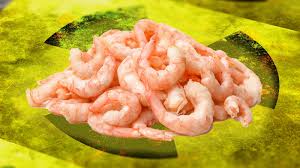
The Bikini Atoll and Castle Bravo
One of the most infamous cases occurred in 1954 with the Castle Bravo hydrogen bomb test at Bikini Atoll in the Marshall Islands. The explosion was larger than predicted, and fallout blanketed nearby islands and waters. Radioactive particles contaminated fish, mollusks, and shrimp.
This event triggered international panic after the Japanese fishing vessel Daigo Fukuryū Maru (Lucky Dragon No. 5) returned with radioactive tuna. While shrimp were not the headline, studies in the aftermath showed that crustaceans too had accumulated fallout isotopes. The Bikini Atoll disaster embedded the idea of radioactive seafood into global consciousness.
Chernobyl (1986) and Fukushima (2011)
The Chernobyl disaster primarily contaminated inland waters, but radioactive rivers flowed into the Black Sea, affecting marine life including crustaceans.
The Fukushima Daiichi nuclear accident in Japan in 2011 reawakened global fears. Large amounts of cesium-134 and cesium-137 were released into the Pacific Ocean. Japanese and international scientists monitored marine organisms, including shrimp. Results showed that benthic organisms like shrimp sometimes retained isotopes longer than fast-moving pelagic fish. This meant shrimp could be more reliable indicators of long-term contamination in seabeds.
Scientific Studies on Radioactive Shrimp
Pathways of Contamination
Shrimp can become radioactive through two primary routes:
- Direct Absorption from Water – Radioisotopes dissolved in seawater pass through gills or diffuse into tissues.
- Dietary Intake – Shrimp consume plankton, detritus, or microalgae containing isotopes.
Once ingested, isotopes may behave like essential minerals. For instance:
- Cesium-137 behaves like potassium, accumulating in soft tissues.
- Strontium-90 mimics calcium, becoming incorporated into the exoskeleton.
Laboratory Experiments
Controlled experiments have exposed shrimp to radioactive tracers to measure uptake rates. These studies reveal that shrimp accumulate isotopes quickly but may also depurate them (excrete or lose them) over time. Factors such as water temperature, salinity, and molting cycles affect retention.
Genetic and Physiological Effects
Radiation can damage DNA, potentially leading to mutations. In shrimp, laboratory studies have shown:
- Increased rates of abnormal larvae when exposed to high radiation.
- Reduced fertility and hatching success.
- Cellular damage in gill and digestive tissues.
However, many shrimp populations appear surprisingly resilient to low levels of chronic exposure. Unlike humans, who may live decades, shrimp have relatively short lifespans, reducing long-term effects.
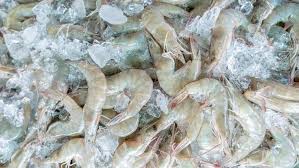
Cultural and Mythological Dimensions
Radioactive Monsters in Popular Culture
The mid-20th century saw a boom in science fiction films featuring giant, mutated creatures spawned by radiation. While giant ants, spiders, and lizards dominated cinema, the idea of a monstrous radioactive shrimp has appeared in parodies and cartoons.
Internet culture has kept the trope alive, with memes about “shrimp that glow in the dark” or “mutant prawns from Fukushima.” Though exaggerated, these images reflect real anxieties about food contamination.
Seafood Scares
Public fear of radioactive seafood often outpaces the actual risk. After Fukushima, global consumers avoided Japanese seafood, even when tests showed radiation far below harmful levels. Shrimp, being a staple in sushi and Asian cuisine, sometimes bore the stigma.
The phrase “radioactive shrimp” thus works as a cultural shorthand for unsafe food, technological disaster, and the uneasy relationship between humans and the sea.
Human Health and Shrimp Consumption
Radiation Exposure through Diet
Radiation exposure is cumulative, but eating seafood with trace isotopes rarely adds much to a person’s dose. For perspective:
- A dental X-ray delivers about 10 microsieverts (μSv).
- A year of natural background radiation delivers 2,000–3,000 μSv.
- Eating a kilogram of shrimp with slight contamination might add less than 1 μSv.
Thus, the health risk from shrimp is negligible unless seafood comes from a severely contaminated area.

Regulations and Monitoring
Countries enforce strict standards for radiation in food. In Japan, for instance, the limit for cesium in seafood is 100 becquerels per kilogram. Shrimp sold in markets are tested, and imports worldwide are routinely screened.
As a result, commercially available shrimp today are safe. The “radioactive shrimp” is more a cultural image than a dietary danger.
Shrimp as Scientific Tools
Bioindicators of Contamination
Shrimp are useful for environmental monitoring. Their sedentary lifestyle, high sensitivity to pollutants, and role in the food chain make them excellent bioindicators. Scientists often measure isotopes in shrimp to track radioactive spread after accidents.
Potential Biotechnology Applications
In the future, scientists envision shrimp engineered to act as “biosensors.” For instance, shrimp modified with fluorescent proteins could glow in the presence of certain contaminants. A “radioactive shrimp” in this sense might serve as a living detector for nuclear waste leakage.
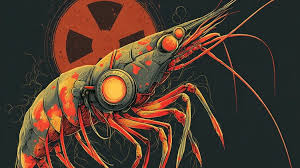
Environmental and Ethical Considerations
Oceans as Nuclear Dumps
In the 20th century, some nations disposed of nuclear waste at sea. Shrimp and other bottom dwellers risked long-term exposure. Though this practice is now banned, it underscores the ethical dilemmas of marine contamination.
Climate Change and Multiple Stressors
Shrimp populations already face stress from overfishing, habitat destruction, and climate change. Adding radioactive contamination to the list highlights the interconnected threats of the Anthropocene.
The Future of Radioactive Shrimp Research
Scientific Importance
Studying shrimp in contaminated zones provides insights into resilience and adaptation. Lessons learned may apply to other species, including humans.
Public Imagination
The myth of radioactive shrimp will likely persist, blending humor, horror, and cautionary symbolism. From memes to speculative fiction, shrimp glowing with radiation will remain part of popular culture.
Conclusion
The phrase “radioactive shrimp” may sound humorous, absurd, or terrifying. But it represents a real intersection of science, history, and culture. Shrimp, as vital members of marine ecosystems and human diets, have been touched by the atomic age—absorbing fallout from weapons tests, surviving nuclear accidents, and symbolizing anxieties about invisible dangers.
From a scientific perspective, shrimp serve as bioindicators of radioactive contamination, helping researchers monitor marine environments. From a cultural perspective, they embody the unease of living in a nuclear world, where the boundaries between natural food and technological hazard blur.
Ultimately, radioactive shrimp remind us of the interconnectedness of life. What humans release into the atmosphere and oceans does not vanish; it flows through ecosystems, into the smallest crustaceans, and sometimes back onto our plates. Understanding radioactive shrimp is, in essence, understanding our responsibility toward the planet we share.
